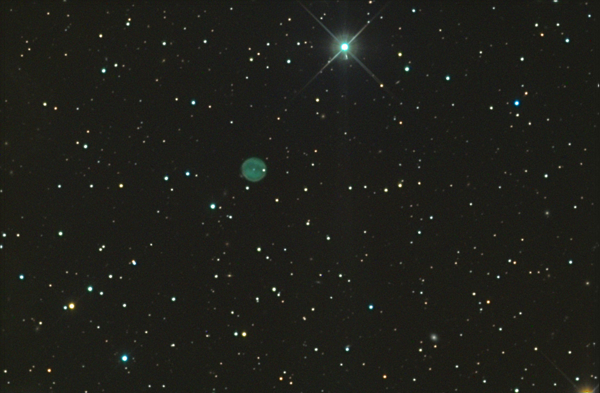NGC 6633 in Ophiuchus and NGC 6742 in Draco
July 2021 - Nebula and Cluster of the Month
Culminating at an altitude of 43° in mid-Britain at midnight on 16th July, NGC 6633 is well placed for observing throughout July. This open cluster was initially discovered by de Chaseaux in around 1745 and then independently discovered by Caroline Herschel in 1783. It was observed by her brother William on 3rd November 1786. William described it as A cluster of considerably scattered little stars
, placing it his class VIII (coarsely scattered clusters of stars) as no. 72.

Whilst this description may be accurate, there is much more that can be said for this cluster. Firstly, and to some perhaps most importantly, it is pleasing to the eye. With low to medium magnification, it shows as an elongated grouping of bright stars, stretching more-or-less north-east to south-west. The diameter of the cluster (or more accurately, the length of the cluster) is given as 20’ by Archinal & Hynes and as 27’ by the Deep Sky Field Guide to Uranometria. My own rough estimate was 30’ when I made my observation.
The number of stars in the cluster is given as 30 by Uranometria and The Night Sky Observer’s Guide, 38 by Wikipedia and, rather enthusiastically, as 159 by Archinal & Hynes. My own count of stars that looked like they could be members was about 50. It just depends on what you count. The cluster contains at least seven catalogued double stars.
The Trumpler classification (given by Archinal & Hynes) is III2m, meaning that the cluster is detached from its background, has no discernible concentration, is composed of both bright and faint stars, and that it is moderately rich. The definition of ‘moderately rich’ is 50 – 100 stars, which is at odds with A&H’s own listing of 159 stars, and also with the much lower estimates given in other sources.
This month’s nebula is a somewhat more challenging object, but is well placed in July for northern observers, culminating at 85° at midnight on the 24th July in mid-Britain.
NGC 6742 lies in Draco; whose head lies close to the zenith on Summer nights. It is a planetary nebula with a low surface brightness, so may require some teasing to pull out from the summer sky.
It was discovered, unsurprisingly, by William Herschel on 8th July 1787. He placed it in his class III (very faint nebulae) as no. 742. He described it as very faint, stellar, verified 300 [magnification]
, a description that survived unchanged into the NGC. The description of this object as ‘stellar’ is odd, as it is 30” in diameter. It is small, certainly, but quite clearly not stellar.

It is also certainly faint, usually being ascribed a visual magnitude of 13.4 (though considerably fainter photographically). It has a fairly smooth disc with hints of annularity. It is almost, but not quite circular and in images shows a clear green colour.
Visually, I find it difficult, though not impossible, through my 12” (300 mm) under moderately poor skies. It is faint in an unfiltered view, but clearly visible most of the time. The addition of an OIII filter very much improves the view. With the filter in place, I can see a small, smooth disc, which just occasionally hints at a slight elongation. The central star is a very difficult object at magnitude 19.4.

Patrick Maloney (DeepSkyBagger@gmail.com)
| Object | RA | Dec | Type | Magnitude |
|---|---|---|---|---|
| NGC 6633 | 18h 27m 16s | +06° 31’ 58” | Open cluster | 4.6 |
| NGC 6742 | 18h 59m 20s | +48° 27’ 55” | Planetary nebula | 13.4 |